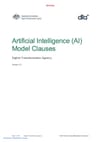📦 What’s Covered
The document offers a flexible contract toolkit designed for three procurement scenarios:
- Services using AI (e.g., chatbots for call centers),
- Bespoke AI development, and
- Software procurement (forthcoming clauses).
Each clause is categorized and optional, allowing government buyers to tailor contracts based on the risk level and specific AI use case. The sections cover:
- Approvals and Restrictions: Sellers must seek approval for any AI use and disclose banned systems (e.g., DeepSeek products).
- AI Development Obligations: When building a new AI tool, sellers must follow detailed provisions for intended use, incident notification, fairness, warranties, and circuit breakers.
- Compliance and Privacy: A robust legal baseline, including mandatory adherence to Australia’s AI Ethics Principles, discrimination laws, and privacy obligations under the Privacy Act.
- Oversight & Explainability: Emphasis on human oversight, transparency of decision-making, and mechanisms to understand and audit AI outputs (e.g., prompts to discourage over-reliance, version control).
- Training & Monitoring: Provisions for dataset quality, algorithm testing, model drift detection, and optional clauses for buyer-led validation and training oversight.
- Security, IP & Handover: Detailed protections around Buyer Data, clear IP ownership options, and procedures for data return or destruction at contract closeout.
- AI Risk Management: Supports both ISO/IEC 42001-compliant systems and project-specific risk frameworks—particularly useful for high-risk or high-profile AI deployments.
The document ends with a comprehensive glossary that defines AI-related terms in legally operable language, helping clarify scope and expectations for both parties.
💡 Why it matters?
This model is a practical leap forward for operationalizing AI ethics and risk management in public procurement. It translates abstract AI principles into enforceable contract terms—especially vital for buyers lacking deep technical expertise. The clauses support due diligence, mitigate supplier-side opacity, and help build public trust by requiring transparency, fairness, and auditability. Its modularity makes it adaptable across sectors and system types, encouraging responsible innovation without stalling procurement agility.
🧱 What’s Missing
While detailed and forward-thinking, the clauses could benefit from more:
- Guidance on supplier capacity assessments, especially for SMEs.
- Templates for annexes (e.g., pre-filled Statement of Requirements).
- Examples of unacceptable “black box” behavior or transparency thresholds.
- Stronger provisions for AI-specific incident response coordination.
- Mandates for public disclosure or registry of high-risk deployments, in line with upcoming global trends.
Also, while it references ISO/IEC 42001, the interplay with newer standards like the EU AI Act or NIST RMF isn’t explored (likely due to timing).
👥 Best For
This resource is ideal for public sector buyers, policy teams, and legal counsel in Australia procuring or developing AI systems. It’s also helpful for vendors bidding on government AI contracts who need to understand risk and compliance expectations. Useful in regulated industries outside government too.
📚 Source Details
Title: Artificial Intelligence (AI) Model Clauses – Version 2.0
Publisher: Digital Transformation Agency, Australian Government
Date: 2019
License: Creative Commons Attribution 4.0
Link: https://www.dta.gov.au (document provided by user)
Length: 46 pages
Covers: Contract templates for responsible AI procurement, aligned with Australia’s AI Ethics Principles.


